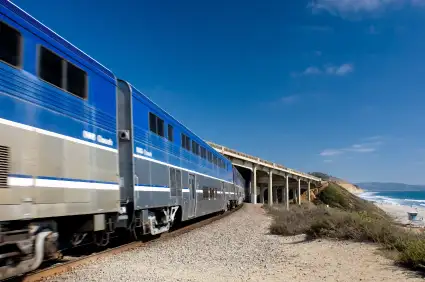
A caption to an online photo post of the train that derailed in northwestern Spain on Wednesday asks, “Are trains safe?” That’s a good example of the false distinction between “safe” and “unsafe.” In reality, safety isn’t an either/or value; it’s a gradation. Nothing is 100 percent safe. Nothing is 100 percent unsafe. Planes make bad landings, trains careen off the rails, buses overturn, ships run aground, people fall out of roller coasters. And no matter how hard everyone tries to prevent them, we all know these things will happen again.
The laws of physics make transportation especially vulnerable to safety problems. Transportation means moving, and moving means energy—energy to get started, more energy to stop. Stopping or turning a large moving mass takes a lot of energy and a lot of time. Go around a curve too fast and centrifugal force throws you off the rails or highway. Hitting a brick wall when you’re in motion can demolish you or whatever is carrying you. Gravity accelerates mass at a rate of 32 feet per second per second. This isn’t going to change.
Most mechanical problems tend to be one-off events. When a failure is identified, manufacturers and operators take steps to make sure that specific failure does not happen again. That’s why most mechanical failures are unexpected—and unpredictable.
The one recurring failure that pervades all of transportation is human error. At least initially, human error appears to be a primary element in both the Spanish train wreck and the Asiana crash in San Francisco. It certainly caused the Costa Concordia grounding.
As Ron White said, you can’t fix stupid. You can’t fix human error either—at least not completely. Yes, we can do better screening of employees—conduct better training—and install better warning systems. But, surely, some captain will again run his cruiseship aground, some pilot will misjudge his approach altitude, some train driver will take a tight curve too fast.
So a serious answer to the “is it safe” question, at best, is that ships, airplanes, trains, and buses are as safe as we can make them and are operated as safely as we can run them, but nothing is perfectly safe. And—more to the point—we can’t predict when, where, or to whom the next major safety problem will occur. The only way to be completely safe from transportation accidents is to stay home—and even there, you can slip on a bathroom tile.
You Might Also Like:
We hand-pick everything we recommend and select items through testing and reviews. Some products are sent to us free of charge with no incentive to offer a favorable review. We offer our unbiased opinions and do not accept compensation to review products. All items are in stock and prices are accurate at the time of publication. If you buy something through our links, we may earn a commission.
Related
Top Fares From
Today's Top Travel Deals
Brought to you by ShermansTravel
Kenya: 14-Night Tour, Incl. Tanzania &...
smarTours
 vacation
$7125+
vacation
$7125+
7-Night Caribbean Round-Trip Cruise From Orlando:...
Norwegian Cruise Line
 cruise
$739+
cruise
$739+
Ohio: Daily Car Rentals from Cincinnati
85OFF.com
 Car Rental
$19+
Car Rental
$19+



